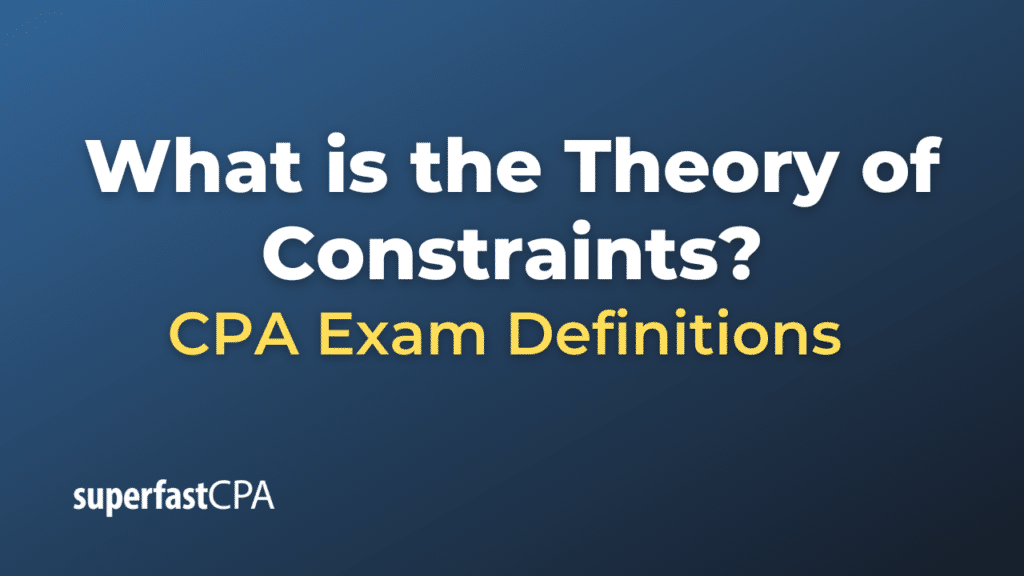Theory of Constraints
The Theory of Constraints (TOC) is a management philosophy introduced by Dr. Eliyahu M. Goldratt in his 1984 book “The Goal.” TOC is centered on the principle that any manageable system is limited in achieving more of its goals by a very small number of constraints, and that there is always at least one constraint. The key is to identify and address that constraint in order to improve the performance of the system.
Here’s a simplified overview of the Theory of Constraints:
- Identify the Constraint: Every system (like a manufacturing process) has bottlenecks that limit its output. The first step is to identify these bottlenecks or constraints. They can be physical (like a slow machine) or managerial (like a policy or procedure).
- Exploit the Constraint: Make sure the identified constraint is working at its maximum capability. This means ensuring that the bottleneck resource is utilized to its fullest and not wasted.
- Subordinate Everything Else to the Decision Made in Step 2: This means everything else in the system should support the bottleneck’s maximum performance. For example, if a machine is a bottleneck, ensure it always has materials to work on and is never waiting.
- Elevate the Constraint: If after fully exploiting the constraint it still remains a bottleneck, consider ways to increase its capacity. This could involve investing in more machines, hiring more staff, or other means of increasing the throughput of the constraint.
- Repeat the Process: Once you’ve improved the performance of one constraint, another will emerge as the new constraint. Go back to the first step and repeat the process, continuously seeking improvements.
One of the significant takeaways from the TOC is the idea that optimizing a part of the system (like a single process in manufacturing) doesn’t necessarily optimize the entire system. It’s more effective to focus on the constraint or bottleneck that limits the overall system.
TOC has been applied to various areas beyond manufacturing, including project management, supply chain, and services, and it offers tools and techniques tailored to each of these areas.
Example of the Theory of Constraints
Let’s use a simplified example involving a sandwich-making process to illustrate the Theory of Constraints (TOC) in action:
Sandwich Shop Scenario:
Imagine a sandwich shop with three distinct steps to make a sandwich:
- Toasting the Bread: 1 minute
- Adding the Fillings (meat, cheese, veggies): 2 minutes
- Wrapping and Billing: 1 minute
Each step is manned by a different person. Let’s determine the shop’s constraints and apply TOC principles:
1. Identify the Constraint:
By observing, you see that the step of “Adding the Fillings” takes the longest. This step becomes a bottleneck. While one sandwich is being filled, the toasted bread for the next sandwich starts to pile up, waiting for fillings.
2. Exploit the Constraint:
Ensure that the person adding the fillings is doing so as efficiently as possible. This might mean having all fillings pre-sliced and easily within reach or providing additional tools to speed up the process.
3. Subordinate Everything Else to the Decision Made in Step 2:
Since adding the fillings is the constraint, it makes sense to ensure that no bread is toasted until the filling station is ready for it. This can help in reducing the pile-up of toasted bread and ensures the filling station is continuously working.
4. Elevate the Constraint:
To further address the bottleneck, consider adding another person to help with adding the fillings. With two people working on fillings, the time might reduce to close to 1 minute per sandwich, aligning with the other steps in the process.
5. Repeat the Process:
After making the above changes, observe the process again. Now, with two people on fillings, you might discover that the new constraint is the wrapping and billing step because it struggles to keep up with the faster pace. Again, you’d follow the TOC steps to address this new constraint.
In the real world, the challenges and constraints are often more complex than this simplified example, but the principles of TOC remain the same. It emphasizes looking at the whole system, understanding its constraints, and making strategic decisions to optimize the system’s overall performance.














